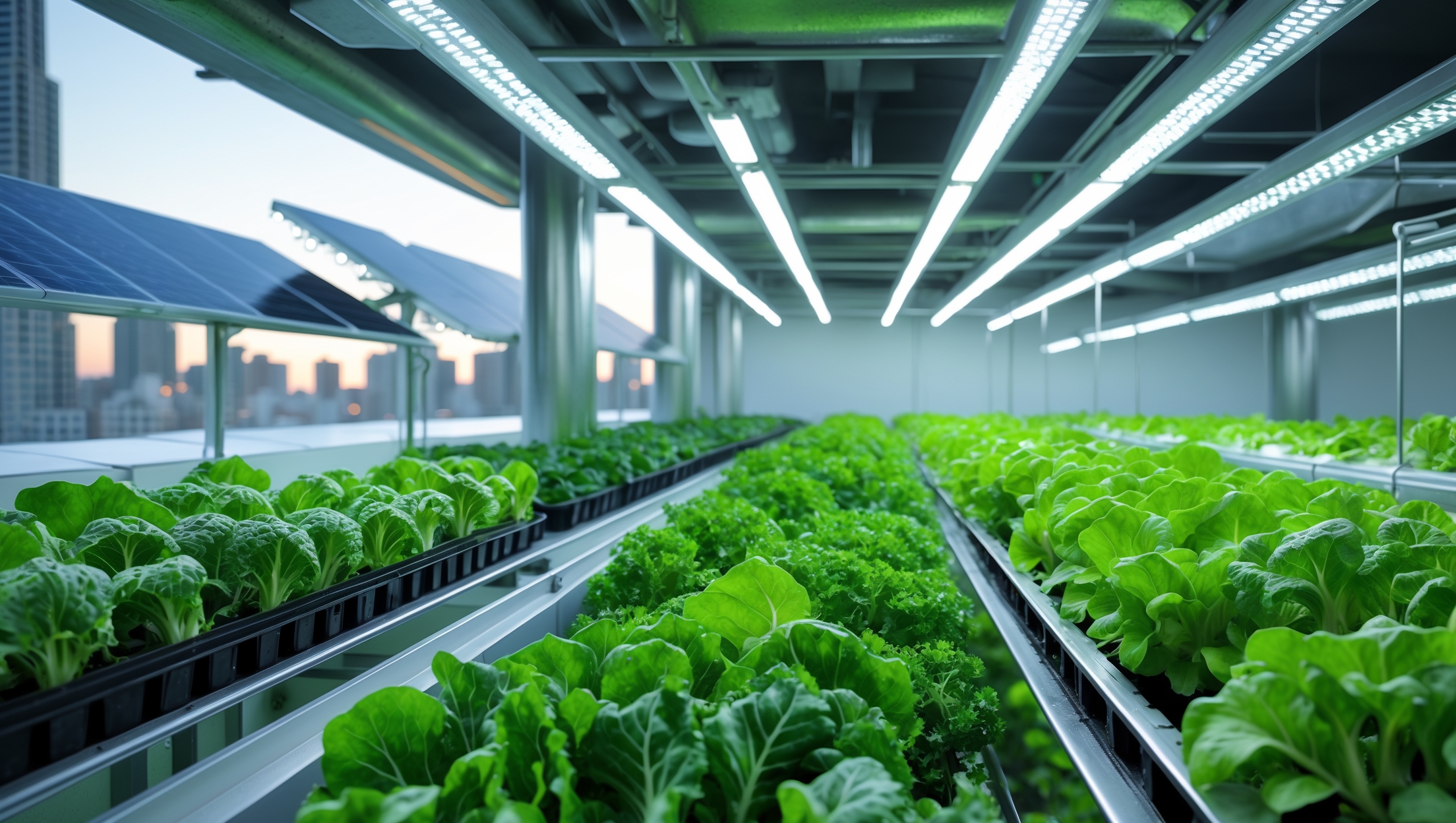Introduction: The Rise of Urban Vertical Farms Powered by Renewable Energy
As cities grow denser and land becomes a scarce resource, urban vertical farming has emerged as a transformative solution to local food production. These innovative farms use advanced hydroponic or aeroponic systems to cultivate crops in stacked layers, maximizing yields per square foot. When powered by renewable energy sources such as solar panels, wind turbines, or even micro-hydro systems, these operations achieve a new level of sustainability, reducing both the carbon footprint of food production and the energy costs associated with traditional agriculture.
But with sustainability becoming a selling point for many businesses, how can your urban vertical farm stand out in a crowded market? Beyond the technical setup and operational efficiency, your ability to market the unique blend of fresh, locally grown produce and renewable energy-powered operations can define your success. In this comprehensive guide, we’ll explore effective, actionable marketing strategies tailored for urban vertical farms leveraging green technologies. Whether you’re just starting out or seeking to expand your reach, you’ll find practical advice on branding, customer engagement, partnerships, and digital marketing that will help you attract eco-conscious consumers and build a resilient, future-ready business.
Understanding Your Unique Selling Proposition (USP)
Defining What Sets You Apart
Urban vertical farms powered by renewable energy offer a distinctive value proposition. Clearly defining and communicating your USP is the cornerstone of any marketing strategy. Consider:
- Freshness & Locality: Shorter farm-to-table time means fresher produce for city dwellers.
- Year-Round Production: Controlled indoor environments allow for consistent crop availability, regardless of season.
- Resource Efficiency: Advanced hydroponics use up to 90% less water than traditional farming.
- Minimal Carbon Footprint: Renewable energy integration drastically reduces emissions associated with food production and transportation.
- Transparency: Urban proximity invites community engagement and on-site tours, enhancing trust.
Craft messaging around these tangible benefits. For example, “Zero-emission lettuce harvested hours before your meal” is a compelling, specific statement compared to generic claims.
Building a Strong Brand Around Sustainability
Visual Identity and Messaging
Your brand should reflect your commitment to sustainability and innovation. Consider the following steps:
- Logo & Colors: Use natural, earth-inspired colors (greens, blues, browns) and incorporate visual elements representing both urban landscapes and renewable energy (e.g., solar panels, wind turbines, city skylines).
- Storytelling: Share your farm’s origin story. Highlight your motivation for combining urban farming with clean energy. Consumers connect with authenticity.
- Certifications: Pursue third-party sustainability certifications (e.g., USDA Organic, LEED, Green-e) and display them prominently.
Consistent Communication
Ensure all marketing materials—website, social media, packaging—consistently convey your green mission and the practical impact of your operations.
Targeting the Right Audience
Identifying Your Ideal Customer
Segment your audience to focus on those most likely to value your unique offering. Key target groups include:
- Eco-Conscious Consumers: Urbanites seeking to reduce their environmental impact.
- Health-Focused Buyers: Individuals prioritizing fresh, pesticide-free produce.
- Restaurants & Cafes: Eateries looking to showcase local, sustainable ingredients.
- Grocery Retailers: Stores that curate premium, local, and green goods.
- Institutional Buyers: Schools, hospitals, and corporate cafeterias interested in sustainable sourcing.
Develop customer personas to tailor your messaging and outreach strategies accordingly.
Digital Marketing Tactics for Vertical Farms
Website Essentials
Your website is your digital storefront. Make sure it includes:
- Clear About Page: Explain your sustainable approach, energy sources, and farming methods.
- Product Listings: Showcase available crops, harvest schedules, and order options.
- Blog or News Section: Share updates on your renewable energy systems, crop experiments, and community involvement.
- Booking Tool: Allow customers to schedule farm tours or sign up for CSA (Community Supported Agriculture) boxes.
- Energy Dashboard: Display real-time stats from your renewable systems—solar kWh generated, CO2 saved, etc.—to build credibility.
SEO Best Practices
Optimize for keywords like “urban vertical farm [City],” “solar-powered urban farm,” or “sustainable produce near me.” Use schema markup for local business, products, and events to improve visibility in search results.
Social Media Engagement
- Instagram & TikTok: Share time-lapse videos of plant growth, behind-the-scenes looks at your renewable energy systems, and harvest moments.
- Facebook: Create events for farm tours, farmers’ market appearances, or workshops on urban agriculture and clean energy.
- LinkedIn: Connect with potential B2B buyers and partners in sustainability-focused industries.
- Hashtags: Use targeted hashtags (#UrbanFarming, #SolarGrown, #CleanEats, #SustainableCity) to expand your reach.
Email Marketing
Build a mailing list through your website and at events. Send regular newsletters with:
- Seasonal produce availability
- Updates on energy milestones (e.g., “Powered 100% by solar this month!”)
- Exclusive offers for subscribers
- Invitations to workshops or tours
Content Marketing
Educate your audience with in-depth blog posts or videos on topics such as:
- How renewable energy powers your farm
- The benefits of hydroponic growing
- Reducing food miles and carbon emissions
- Urban food security and resilience
Leveraging Local Partnerships
Collaborate with Restaurants and Chefs
Offer exclusive microgreens, salad mixes, or herbs to local restaurants. Co-create signature dishes that highlight your produce and your farm’s commitment to clean energy. Encourage chefs to feature your brand on their menus, and document collaborations on both your social channels.
Retail Partnerships
Approach independent grocers and specialty food stores. Provide point-of-sale materials that explain your renewable energy story. Consider co-hosting in-store tastings or educational events.
Community Supported Agriculture (CSA) and Subscription Boxes
Launch a CSA program or produce subscription service. Highlight the added value of supporting not just local farming, but a farm powered by 100% renewable energy. Offer tiered options for different household sizes and culinary interests.
Urban Agriculture Networks
Join local urban farming associations, green business groups, and sustainability coalitions. Attend meetups, sponsor workshops, and share your knowledge about integrating renewable energy into food production.
Showcasing Your Green Credentials
Transparency and Impact Tracking
Consumers increasingly demand transparency. Use infographics and digital dashboards to display measurable impact, such as:
- Energy generated from renewables per month
- CO2 emissions avoided
- Liters of water saved versus traditional farming
- Food miles reduced by hyperlocal distribution
Update these metrics regularly and share milestones with your audience via social media and newsletters.
Farm Tours and Open Houses
Invite the public to see your systems in action. Demonstrate your hydroponic setups, renewable energy installations, and food safety protocols. Offer samples and Q&A sessions to build community trust and engagement.
Event Marketing and Educational Outreach
Workshops and Classes
Host workshops on topics such as home hydroponics, rooftop gardening, or DIY solar integration. These events position you as a thought leader and attract a community of sustainability enthusiasts.
School and Youth Programs
Partner with local schools for educational field trips. Develop curriculum modules on urban agriculture and renewable energy, and offer hands-on learning experiences in your facility.
Farmers’ Markets and Pop-Ups
Participate in farmers’ markets, pop-up events, and food festivals. Bring portable displays to showcase your renewable energy systems. Offer tastings of your produce and distribute informative flyers or QR codes linking to your impact dashboard.
Media Relations and Storytelling
Press Releases and Media Outreach
Draft press releases for major milestones—opening, achieving net-zero status, launching new products, or entering new partnerships. Reach out to local newspapers, green lifestyle magazines, and sustainability bloggers.
Share Customer Success Stories
Feature testimonials from chefs, retailers, or families who benefit from your fresh, sustainably grown produce. Use video interviews or written stories with photos to humanize your brand and build credibility.
Leverage Awards and Recognition
Apply for green business awards and innovation grants. Display badges and certificates online and in your facility to reinforce your leadership in sustainable urban agriculture.
Measuring Marketing Success and Continuous Improvement
Key Performance Indicators (KPIs)
Track a mix of digital and real-world KPIs:
- Website traffic and conversions (newsletter signups, online orders)
- Engagement rates on social media
- CSA and subscription box growth
- Repeat purchases and customer retention
- Media mentions and backlinks
- Event attendance and feedback
Soliciting Feedback
Regularly survey your customers for feedback on both your produce and your sustainability messaging. Use insights to refine your offerings and adjust your marketing tactics.
Adapting to Market Trends
Stay informed about trends in urban agriculture, consumer preferences, and renewable energy innovation. Be ready to pivot your marketing as new opportunities or challenges arise.
Conclusion: Growing Your Urban Vertical Farm with Purpose and Visibility
Urban vertical farms powered by renewable energy are more than just a trend—they’re a blueprint for a resilient, sustainable urban food system. But harnessing the power of clean energy and advanced farming techniques is only half the challenge. To thrive, your farm must also connect meaningfully with consumers, partners, and the broader community.
By clearly articulating your unique value proposition, building a trustworthy and inspiring brand, and using a mix of digital and local marketing strategies, you can establish your farm as a leader in both sustainable agriculture and renewable energy. Whether you’re selling salad greens to local restaurants, subscription boxes to families, or hosting educational workshops, every interaction is a chance to tell your story and demonstrate your impact.
The most successful urban vertical farms are those that embed transparency, innovation, and community in everything they do. As the market for sustainably grown, clean-energy produce expands, your ability to market your farm’s green credentials will become an ever-more critical differentiator. Invest in your story, your partnerships, and your ongoing engagement with customers and stakeholders. In doing so, you’ll not only grow your business—you’ll help cultivate a healthier, greener future for your city and beyond.





I’m just starting to plan a vertical farm and I’m trying to figure out how to highlight both the freshness and the renewable energy aspect in my marketing. Do you have examples of effective ways new farms have communicated this dual focus to city customers?
You can combine both messages by emphasizing ultra-fresh, locally grown produce delivered within hours, alongside clear visuals or certifications about your renewable energy use. Many urban farms use tags like ‘harvested today, powered by clean energy’ on packaging and signage. Social media campaigns often feature behind-the-scenes photos of the farm’s green technology and stories about how renewable power supports quality and sustainability. In-store tastings or farm tours focusing on both freshness and your energy practices can also help build customer trust and interest.